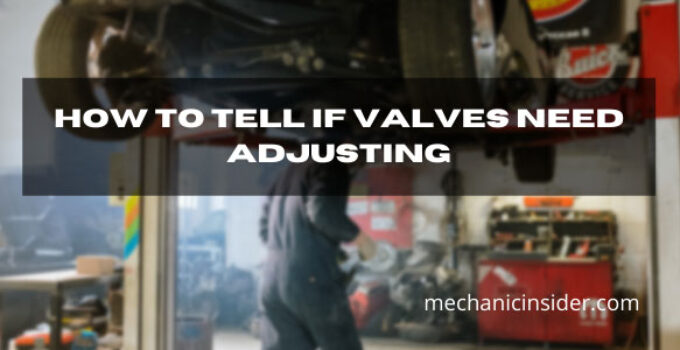A common issue that engines have is the problem with the valves. The valves often get too loose or tight and disrupt the engine’s performance. This lack of efficiency can also result in damaging the engine.
If there’s something wrong with the valves, the first thing that you should notice is a rattling noise. The noise confirms that something is causing the engine to work unevenly. So, then you can check the valves out to see if there’s any problem.
It’s crucial that you know how to tell if valves need adjusting. Because you won’t always have the opportunity to get help from an expert. So, knowing this stuff will save a lot of your time!
Why You Need a Valve Adjustment
A valve adjustment motorcycle is mandatory for the health of your engine. That’s because it ensures proper combustion of the fuel.
Sadly, this task is overlooked most of the time during engine maintenance. Neglecting the importance of valve position can lead to problems like low fuel efficiency and power loss.
So, you must look after the valve lash as it can alert you to problems before they cause any major damage. Because any sort of heavy damage will require hefty repair costs and prolonged downtime.
It’s mandatory that you learn how to tell if valves need adjusting motorcycle. If someone asks you – do valves need to be adjusted? Tell them the problems mentioned below that can occur if the valves are not adjusted correctly.
- These issues include:
- The fuel will burn out quicker
- Increase in exhaust smoke
- The engine won’t be able to operate at full power
Signs That Valves Need Adjusting
Adjusting a valve requires you to understand what Valve Clearance is. It’s the gap between the rocker arm and the valve.
When the camshaft rotates, the entire force is exerted on the rocker arm. It pivots downwards and opens up the valve. The gap within those parts when the rocker arm is not experiencing any force from the cam is known as the Valve Clearance.
So, to know how to tell if valves need adjusting ATV, you ought to know about valve clearance. It should be adequately maintained to ensure the functioning of the engine. And the clearance must be checked on a closed valve. It’s because there’s no clearance when the valve is wide open.
Also, it should be measured only on a cold standby engine. Taking measurements on a machine that has just been run or is hot will not show accurate results.
So, if you have this question- how do I know if I need my valves adjusted, you’ve to understand how to tell if valves need adjusting dirt bikes.
Here are the signs that’ll tell you when it’s time to fix the valves:
Pre-ignition
One of the diesel valve adjustment symptoms is pre-ignition. This condition occurs when the fuel inside the combustion chamber ignites all by itself, even before the spark plug can initiate.
The reason for this problem occurring is that the engine gets heated and reduces the valve clearance. So, if a valve is poorly adjusted, the lack of clearance prohibits the exhaust valves from releasing the heat.
This build-up of excess heat eventually grows large and ignites the air-fuel mixture even before the spark plug starts to work. It can even result in engine knocking and internal damage. If you’re facing pre-ignition issues on your bike, and it’s safe to say that you haven’t had your valves checked in a long time.
So, as you now know how to tell if valves need adjusting honda pioneer due to the pre-ignition problem, you should be extra careful and get the engine checked.
Rattling Noise
Sometimes the rattling noise that comes out of the engine is because of the loose valves. It’s one of the most common valve adjustment symptoms.
If you suddenly hear a change in the valve train noise, you should understand that the valves need to get an adjustment right now. Loose valves tend to wear your valve train components. It also ends up increasing the clearance, which causes major compression issues.
Tightening the valves too much will also disrupt the function of the engine. So, the debate is not tight valves vs. loose valves but finding the perfect spot that ensures the engine’s best performance.
Overheating
Another one of the signs that valves need adjusting on a dirt bike is an overheating engine. This occurs due to the lack of clearance.
The lack of enough clearance slows the valves down. And when the valves are kept closed for a longer time, the heat will obviously build up. This additional amount of time that the valves take then ends up overheating the engine.
Excess heat causes significant performance issues. If the engine is overheated, it could deform the valves and even cause them to break. This will then cause severe functional issues, resulting in a costly rebuild.
So, if you face this sort of problem and want to solve it, the valves are a good place to begin with.
Increased Fuel Consumption
If the fuel intake of your motorcycle has increased out of nowhere, it’s signs valves need adjusting. The reasons can be too tight or loose valves on the cylinder.
There’s a chance that the exhaust valve remains open while air and fuel are coming through the intake valve. This mixture goes directly through the cylinder and then gets out through the exhaust valve.
Valvetrain Failure
Valvetrain failure is also one of the small engine valve adjustment symptoms. If the valves in the engine are poorly adjusted, it’ll naturally cause damage to the whole valve train.
Valves with too much clearance can damage rocker arms, camshaft lobes, and even the valves. If your valve train components failed for no reason, then check out if the valve clearance is correct or not.
How To Adjust Valve Clearance
Adjusting the nuts on the valves is a pretty straightforward job. You just have to make sure that you know what you’re looking for.
Here’s a thorough guide to the whole process:
Step 01: Find the inlet and outlet valves.
Step 02: Now, turn the engine until you fully close the valve.
Step 03: Insert a feeler gauge and find the exact amount of gap inside the valve. Keep changing the sizes of the feeler gauge until you get the exact match. You’ve got to learn how to check valve clearance.
Step 04: Avoid using a standard feeler gauge and go for long feeler strips to use in this case.
Step 05: Loosen the lock nut near the adjuster of the rocker and turn the adjusting screw. You have to turn it anti-clockwise to increase the clearance and clockwise to decrease it.
However, some engines can have stiff adjusting screws that don’t include a lock-nut.
Step 06: Now, run the engine at an idle speed. Insert the feeler gauge inside the rocker pad and valve stem gap.
If the gap’s too small, the feeler won’t fit, and the engine will find it hard to run evenly. But if the feeler gauge rattles, it means that the gap is too wide.
Step 07: Try to adjust the nut until you find that sweet spot and see that the engine is running smoothly. Then the feeler gauge will also stop rattling.
However, if this process seems too difficult, you can also do it while keeping the engine turned off.
Conclusion
Valve adjustments are incredibly crucial for the performance of your engine and the betterment of its health. This is one major issue that shouldn’t be overlooked at any cost.
Although they’re not easy to fix or pay for, they are indispensable for keeping your engine healthy. And now, as you know how to tell if valves need adjusting, you too can do it all by yourself!
Also read: Best SBC head for torque



